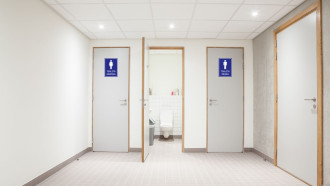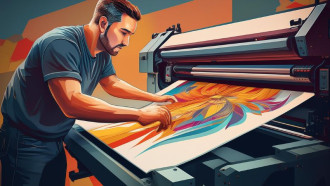The techniques for reproducing paintings are a fascinating area where art meets technology. Choosing the right technique is crucial for obtaining a faithful copy of the original while also affecting the durability, cost, and accessibility of the reproduction. From traditional methods like lithography to modern digital solutions, each technique has its unique characteristics and applications.
What are the techniques for reproducing paintings?
Reproducing paintings can be achieved using various techniques, each offering unique possibilities and applications in different contexts:
1. Offset printing: An industrial printing method based on the principle of repelling water and grease, ideal for large runs of reproductions in books, catalogs, and posters.
2. Giclée: An advanced inkjet printing technique that allows for high-quality reproductions on various substrates, often used for limited art editions.
3. Lithography: A traditional flat printing technique valued for its ability to achieve subtle tones and textures, popular in the reproduction of graphics and drawings.
4. Serigraphy: A screen printing method that allows for intense colors on various surfaces, often used in contemporary art reproductions and posters.
5. Digital printing: A modern technique that allows for direct transfer of an image from a digital file to a substrate, ideal for small runs and personalized reproductions.
6. Handmade reproductions: A traditional method where a copyist artist manually recreates the artwork, offering unique interpretation and artistic value.
Each of these techniques has its specific applications and is chosen based on the nature of the reproduced work, the desired quality, the print run, and the purpose of the reproduction.
<IMG>
Offset printing
Offset printing is one of the most popular industrial printing techniques, widely used in the reproduction of paintings. This method is based on the principle of repelling water and grease. In the offset printing process, the image is first transferred from a flat printing plate to a rubber cylinder and then onto the printing substrate, usually paper.
The offset printing process begins with the preparation of a printing plate, usually aluminum, on which the image is chemically or digitally applied. The plate is then mounted on a cylinder in the printing machine. During printing, the plate is first moistened with water, which adheres to the non-printing areas. Then, oily ink is applied, which adheres only to the printing areas, repelling the water. The image from the plate is transferred to the rubber offset cylinder, and from there to paper or other substrates.
Offset printing is particularly efficient for large print runs, making it an ideal solution for reproductions in books, magazines, art catalogs, and posters. This technique allows for faithful color and detail reproduction, which is crucial in the reproduction of artworks. It is often used to create high-quality reproductions of paintings, graphics, and artistic photographs, especially when a large number of copies are required.
Giclée technique
Giclée is an advanced inkjet printing technique that has revolutionized the world of art reproductions. The name comes from the French word "gicler," meaning "to spray" or "squirt," referring to how the ink is applied to the substrate.
The giclée process begins with high-resolution scanning or photographing the original artwork. The obtained digital image is then precisely adjusted for color and detail to faithfully replicate the original. Specialized high-resolution inkjet printers are used for printing, often equipped with eight or more colors of ink, including various shades of black and gray.
The giclée technique is especially valued in the reproduction of paintings, watercolors, artistic graphics, and photographs. It allows for creating reproductions of exceptional quality on various substrates, such as artistic canvas, watercolor papers, or photographic papers. Giclée is often chosen for creating limited edition reproductions for collectors, art galleries, and museums. It is also popular among contemporary artists who want to create high-quality copies of their original works.
Litography process
Lithography is a flat printing technique that was invented at the end of the 18th century and remains a valued method in the art world. It is based on the principle of mutual repulsion of water and grease.
The lithography process begins with the preparation of a lithographic stone (traditionally) or a metal plate (in newer versions). The artist creates a drawing directly on the stone or plate using greasy crayons or ink. The surface is then etched with a special solution, making the undrawn areas hydrophilic (attracting water), while the drawn areas remain hydrophobic (repelling water).
During printing, the surface of the stone or plate is first moistened with water, which adheres only to the non-printing areas. Oily ink is then applied, adhering only to the drawn, hydrophobic areas. The image is transferred to paper using a lithographic press.
Lithography is particularly valued in the reproduction of artistic graphics, drawings, and some forms of painting. It allows for achieving subtle tones and textures, making it ideal for reproducing works characterized by delicate lines and tonal transitions. It is often used to create limited edition reproductions for collectors and art galleries and for producing high-quality art posters.
Serigraphy
Serigraphy, also known as screen printing, is a versatile printing technique that gained popularity in the art world in the 20th century. It involves pushing ink through a fine mesh screen onto the substrate.
The serigraphy process begins with preparing a mesh screen (usually nylon or polyester) stretched on a frame. A stencil is created on the screen, blocking the areas that are not to be printed. The stencil can be made using various methods, from manually applying blocking substances to photoemulsion techniques.
During printing, the screen is placed over the substrate to be printed. Ink is applied to the top of the screen and then drawn across the screen with a squeegee, forcing the ink through the open areas of the screen onto the substrate. A separate screen and printing pass are required for each color in the design.
Serigraphy is widely used in the reproduction of contemporary art, especially in creating posters, artistic graphics, and reproductions of works characterized by bold, flat areas of color. It is valued for its ability to achieve intense, saturated colors and print on various substrates, from paper to fabrics, metal, and glass. This technique was particularly popular among pop art artists such as Andy Warhol and is still used by contemporary artists to create original works and limited edition reproductions.
Digital printing
Digital printing is a modern reproduction technique that has revolutionized how we create and reproduce images. Unlike traditional printing methods, digital printing does not require the creation of physical printing plates.
The digital printing process begins with preparing a digital file containing the image to be reproduced. This can be a scanned artwork, a digital photograph, or a computer-created graphic. The file is then processed by specialized software that optimizes it for printing.
In a digital printer, the image is transferred directly from the computer to the printing substrate. There are two main digital printing technologies: laser (using toner powder) and inkjet (using liquid inks). Digital printers apply very small dots of ink or toner to the substrate, creating a high-resolution image.
Digital printing is versatile and can be used to reproduce various artworks, from photographs to paintings and digital graphics. It is especially useful for creating small runs, single prints, or when personalization is required. In the art world, digital printing is often used to create proof prints, reproductions of artistic photographs, and produce modern forms of digital art. This technique also allows for easy on-demand reproduction, which is especially valuable for artists and small galleries.
Handmade reproductions
Handmade reproductions, also known as hand copies, are a unique and traditional form of recreating artworks. Unlike mechanical or digital reproduction methods, hand copies are created directly by artists who strive to replicate the original work as faithfully as possible.
The process of creating a handmade reproduction begins with carefully studying the original. The copyist artist analyzes not only the composition and color scheme of the work but also the technique, brush strokes, or surface texture. Then, using similar materials and techniques as the original creator, the copyist begins the meticulous process of recreating the work.
Handmade reproductions can be created using various techniques, depending on the nature of the original, such as:
- Oil painting
- Watercolors
- Pencil or charcoal drawing
- Sculpture
For oil paintings, oil paints on canvas are used, trying to replicate each brush stroke. Watercolors are copied using watercolor paints on appropriate paper, considering the characteristic tonal transitions and transparency of this technique. Drawings can be recreated using pencils, charcoal, or crayons, depending on the original. In the case of sculptures, the copyist can create a replica using clay, stone, or other materials, striving to faithfully recreate the form and texture of the original.
Handmade reproductions are valued in many contexts. In art education, copying master works is a traditional method of learning painting and drawing techniques. Museums and galleries often commission the creation of hand copies of valuable works, which can be used for educational or exhibition purposes when the original is unavailable or too valuable to display. Collectors and art lovers also value handmade reproductions for their unique character and close connection to the original's creative process.
Interestingly, art history knows many cases where well-known artists created copies of other masters' works. For example, Peter Paul Rubens copied the works of Titian, and Vincent van Gogh created his versions of Jean-François Millet's paintings. Such practices were not only a form of tribute to admired artists but also a way of exploring painting techniques and developing one's style.
Handmade reproductions, though time-consuming and requiring significant skills, offer unique value in the world of art reproductions. Each such copy is itself a work of art, bearing the marks of the copyist artist's interpretation and skills while preserving the essence and spirit of the original.
What are the pros and cons of various painting reproduction techniques?
Each painting reproduction technique has unique features that can be advantages or disadvantages depending on the specific application. Choosing the right method depends on many factors, such as the desired quality of the reproduction, the size of the print run, the type of artwork being reproduced, the budget, and the intended use of the final product. The table below presents the main advantages and disadvantages of the most popular techniques, which can help in deciding on the most appropriate method for a given project. It is important to remember that in practice, it is often necessary to find a compromise between various aspects such as quality, cost, and production time.
Comparison of reproduction techniques
| Technique | Advantages | Disadvantages | Applications |
|---|---|---|---|
| Offset printing | High print quality Economical for large print runs |
High initial cost Limited flexibility for small print runs |
Poster reproductions Promotional materials |
| Giclée | Very high quality Ability to print on various materials |
High cost Time-consuming process |
Art reproductions Artistic photographs |
| Lithography | Durability and resistance to fading Ability to create many prints |
Complex process High production costs |
Art prints Reproductions of detailed artworks |
| Serigraphy | High print quality Ability to print on various materials |
Time-consuming High production costs for small print runs |
Poster reproductions Prints on clothing and other materials |
| Digital printing | Low production costs Speed and flexibility Ability to personalize |
Less durability compared to other techniques Limited quality in large formats |
Art reproductions Marketing materials Personalized prints |
| Handmade reproductions | Ability to accurately replicate details Artistic value of handwork |
Very high costs Time-consuming |
Reproductions of famous artworks Private collections |
| 3D printing | Ability to create three-dimensional objects High precision |
High equipment costs Complex model preparation process |
Sculpture reproductions Architectural models Art education |
Analyzing this information, it is clear that there is no single universal technique ideal for all applications. The choice of reproduction method should be made individually, considering the project's specifics, available resources, and the final recipients' expectations.
How to choose the right frame for a reproduction?
Choosing the right frame for a reproduction is a crucial element that affects the final appearance and durability of the work. The frame not only protects the reproduction from mechanical damage, dust, and light but also forms an integral part of the presentation's aesthetics. The choice of the frame and mat should be thoughtful and tailored to the nature of the reproduction, the style of the interior, and individual aesthetic preferences.
The types of frames include a wide range of materials and styles. Wooden frames are a classic choice, offering warmth and elegance, ideal for traditional artworks. Metal frames, on the other hand, give a modern, minimalist look, often chosen for contemporary graphics and photographs. Plastic frames are an economical alternative, available in many colors and styles, although they may be less durable.
The mat is a cardboard frame placed between the picture and the frame, which emphasizes the work and adds depth. The mat not only improves aesthetics but also protects the reproduction from direct contact with the glass, preventing condensation and damage. The choice of the mat's color and width should complement the reproduction's color scheme and style without dominating the work itself.
The choice of framing technique also depends on the type of reproduction. Canvas stretched on stretcher bars can be framed without glass, allowing full appreciation of the texture and details. Prints on paper usually require framing under glass or plexiglass to protect against moisture and damage. UV-filtered glass is especially recommended to protect reproductions from fading caused by light exposure.
The table below presents the advantages and disadvantages of different framing techniques, which can help in making an informed decision:
Choosing the right frame for a reproduction requires considering many aspects, from aesthetic to practical. The final choice should harmonize with the work's character, ensuring its protection and appropriate presentation.
What to look for when buying a canvas print reproduction online?
Buying a canvas print reproduction online can be challenging because you cannot see the product in person before purchase. Here are the key aspects to consider:
1. Product photo quality: Check if the seller offers high-resolution photos that allow you to assess the reproduction's details. Look for photos showing the reproduction from different angles and in various lighting conditions.
2. Technical specification: Pay attention to the print resolution (DPI - dots per inch). High-quality reproductions should have at least 300 DPI. Check information about the inks used (e.g., pigment, fade-resistant).
3. Materials: Ensure the canvas is of good quality (e.g., cotton, polyester blend). Check information about the frame or stretcher bars used (e.g., pine wood, bar thickness).
4. Finish: Look for information about additional protective layers (e.g., UV varnish). Check if the edges of the canvas are printed (important if you plan to display it without an additional frame).
5. Size: Ensure the reproduction dimensions are accurately given and meet your needs. Check if the proportions match the original.
6. Certificates and guarantees: Look for information about authenticity certificates, especially for limited editions. Check if a product warranty and return policy are offered.
7. Customer reviews: Read reviews from other buyers, paying particular attention to comments on print quality and color fidelity.
8. Return and refund policy: Familiarize yourself with the seller's return and refund policy in case the product does not meet your expectations.
9. Packing and shipping methods: Check how the reproduction will be packed for shipping to avoid damage during delivery.
10. Reproduction origin: Ensure the reproduction is legal and does not infringe on copyright.
11. Price: Compare prices from different sellers, but remember that a very low price may suggest low quality.
12. Contact with the seller: Do not hesitate to ask the seller additional questions. Their answers and willingness to provide information can indicate professionalism and product quality.

Jarek
graphic designer and product specialist at Wallyboards
Jarek is a true virtuoso of graphic design software and has been creating unique visual projects since the very beginning of Wallyboards. He’s the one who brings individual customer ideas to life, transforming them into stunning wall decorations. He’s also responsible for developing new products and launching them in our online store.







